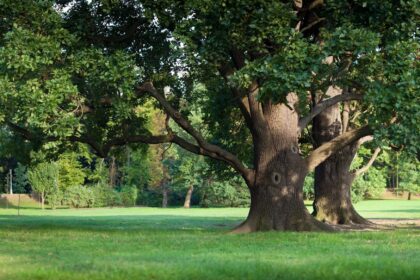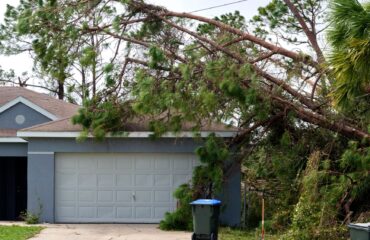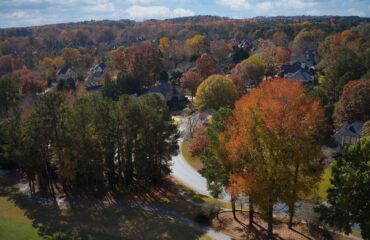
Archer Tree Services’ Comprehensive Guide
A common concern for homeowners and property managers in Georgia is to protect trees from deer browsing. Deer can pose a significant threat to your trees, causing damage to leaves, bark, and even hindering the growth of new saplings.
As homeowners, we invest time, money, and love into our landscapes, taking pride in the beauty and serenity they offer. But, in suburban and rural areas across the country, a common adversary often looms – deer. These graceful creatures can turn into menaces, wreaking havoc on our trees, shrubs, and plants, turning lush gardens into barren landscapes overnight.
To protect trees from deer is much more than just preserving aesthetic appeal–it’s about safeguarding the health of our gardens and yards. Deers’ foraging habits can be destructive to young and mature trees alike, stripping bark and eating buds and leaves. During the mating season, male deer or bucks can further damage trees by rubbing their antlers against them, a behavior known as ‘buck rub.’
At Archer Tree Services, we understand the challenges homeowners face in keeping their landscapes safe from deer damage. We’ve poured our expertise and years of experience into this comprehensive blog to provide you with practical, effective strategies to protect trees from deer. Whether you’re looking for preventative measures or searching for solutions to existing deer issues, this guide can serve as your go-to resource.
Browsing Favorites: Tree Species Vulnerable to Deer Damage
In Georgia, deer are known to cause damage to a variety of tree species. The specific trees they go after can vary based on factors such as the region within the state, seasonal availability, and local habitat conditions. However, there are several species in Georgia:
- Oak trees, especially white and red oaks
- Maple trees
- Sweetgum trees
- Dogwood trees
- Eastern Red Cedar
- Eastern Hemlock
- Pine trees
- Fruit trees, especially apple and pear
While it’s true that deer are opportunistic feeders, certain tree species are less likely to be targeted by these animals. In Georgia, these include:
- Ginkgo: Known for their distinct fan-shaped leaves, Ginkgo trees are typically avoided by deer, most likely due to the unpleasant smell of the fruit.
- Bald Cypress: These trees have feathery, soft foliage that is not a preferred food source for deer.
- American Holly: The spiny leaves of the American Holly make it unappealing to deer.
- River Birch: Deer generally avoid the River Birch, possibly due to its scaly, exfoliating bark.
- Southern Magnolia: The thick, glossy leaves of the Southern Magnolia are less inviting to deer.
Remember, these are general trends, and there can be exceptions based on local conditions and food availability. Planting less palatable tree species can be part of your strategy to protect trees from deer damage. However, a multi-faceted approach involving physical barriers, repellents, and strategic landscaping choices tends to be most effective.
Deer Behavior and its Influence on Tree Health
Now that we’ve discussed the types of trees that are and are not vulnerable to deer in Georgia, let’s delve into the specific types of damage these creatures can inflict. Deer can negatively impact your trees in multiple ways, each leaving a distinct sign of interference. Understanding these signs and the severity of the damage is a crucial step toward implementing tree protection from deer. In this section, we’ll take a closer look at the various forms of harm that your trees might endure from deer activity.
Browsing Foliage
Deer are herbivores and often feed on the leaves and tender twigs of trees. This browsing activity can stunt the growth of young trees and reduce the overall health of mature trees.
Strip Bark
Deer may strip bark from the lower trunks of trees, particularly during the winter months when other food sources are scarce. Bark stripping can girdle the tree, leading to reduced nutrient transport and potentially causing the tree’s death.
Marking Territory
During the rutting season (mating season), male deer may rub their antlers against tree trunks to mark territory and attract mates. This behavior can cause significant damage to the bark and cambium layer of the tree.
Impact on Forest Regeneration
In forested areas, deer can substantially impact the regeneration of new trees. They often feed on young, tender shoots, preventing the establishment of a new generation of trees. Additionally, as deer move through wooded areas, they can trample and compact the soil around the base of trees, potentially damaging their roots.
To mitigate these impacts and protect trees from deer damage, homeowners and land managers in Georgia may employ various strategies, which we will discuss in the next section. It’s important to tailor the approach based on the specific needs of the property and the behavior of the local deer population. Regular monitoring and maintenance of protective measures are also crucial for long-term effectiveness.
Effective Measures that Protect Trees from Deer
Homeowners in Georgia can take several measures to protect trees from deer browsing. Deer can cause damage to trees by feeding on leaves, twigs, and bark, particularly in suburban and rural areas where deer populations are common. Here are some strategies to help protect trees from deer:
Physical Barriers
To protect trees from deer browsing and rubbing, homeowners can utilize netting as a safeguard. There are various fencing options available, including metal, plastic, and electric.
Another effective method is to use tree guards as physical deterrents, preventing deer from damaging tree trunks. These guards are typically made from plastic or metal mesh. Both fences and tree guards should be installed at a height that is out of reach for deer, around 8 feet.
Commercial and Homemade Repellents
There is a wide array of commercial deer repellents available on the market that can effectively protect trees from deer. These repellents should be applied to the foliage and lower branches of the trees. Typically, these commercial repellents contain substances with potent odors or tastes that act as deterrents for deer.
Alternatively, homeowners have the option to create their own deer repellents using ingredients such as eggs, garlic, or hot peppers, which are known for their ability to repel deer. However, it is important to note that the effectiveness of these homemade repellents may vary.
Alternative Food Sources
To deter deer from damaging valuable trees and sensitive plants, it is advisable to strategically plant preferred vegetation in designated areas. Additionally, setting up feeding stations with deer-friendly food sources can effectively redirect their attention.
Visual and Auditory deterrents
Enhance your deer deterrent measures with visual cues like scarecrows or predator decoys. Hang objects that reflect light, such as aluminum foil or old CDs, from trees to startle and discourage deer from approaching. Consider installing motion-activated devices that emit noise, light, or water spray to further startle and deter deer.
Garden Planning
To discourage deer, strategically position specific plants near your trees. For instance, aromatic plants are typically avoided by deer, making them an excellent natural repellent when planted around your trees. Additionally, densely planted areas are less likely to attract deer. Consider selecting tree species that are known to be less appealing to deer, as discussed in the previous section. While no plant is entirely immune to deer browsing, these measures can significantly reduce the likelihood of damage.
Consistent monitoring and maintenance are crucial for the long-term success of these strategies, as deer behavior and preferences can change. Additionally, homeowners should be aware of local regulations and homeowners’ association rules that may impact the available options. The effectiveness of these methods may vary depending on local deer behavior and other factors, so it may require some trial and error to discover the optimal solution for your property.
Archer Tree Services’ Final Thoughts on Tree Protection from Deer
Tree protection from deer damage involves a combination of strategies – from using physical barriers and repellents to strategically planning garden layouts. It is essential to remember that the effectiveness of each method can vary based on the local deer population’s behaviors, and a certain degree of trial and error may be necessary. Homeowners must stay vigilant and adaptable, ready to adjust their strategies as necessary.
Archer Tree Services hopes that this comprehensive guide has equipped you with the knowledge and tools needed to protect trees from deer browsing. We understand the value of your landscape and are committed to helping you protect it. Our team is always ready to assist homeowners in finding the right combination that is effective for their unique circumstances.
Archer Tree Services remains committed to supporting you in your tree care endeavors, offering expertise, professional advice, and a dedication to the well-being of your arboreal investments. Together, we can create landscapes that thrive in harmony with nature, ensuring that your trees stand tall and resilient against the challenges posed by deer and other environmental factors.



